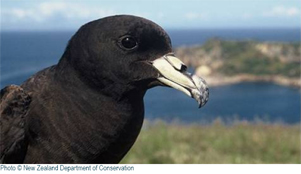Elizabeth (Biz) Bell (Wildlife Management International Ltd) and colleagues have reported to a recent meeting of the Conservation Services Programme Technical Working Group of New Zealand’s Department of Conservation on the at-sea distribution of ACAP-listed Black Petrels Procellaria parkinsoni in relation to fisheries.

Black Petrel, courtesy of the New Zealand Department of Conservation
The draft report’s abstract follows:
“This report is part of an ongoing long-term study of the black petrel, Procellaria parkinsoni, on Great Barrier Island (Aotea Island) that was begun in the 1995/96 breeding season, and aims to describe foraging information and spatial overlap with fisheries. Since the 2005/06 season, 92 Lotek™ geo-locator data-loggers have been deployed on breeding black petrels; of these, 86 were retrieved for analysis. These indicated that the foraging range for the black petrels was highly variable and inconsistent between breeding phase and sex. During the breeding season, birds foraged around the northern New Zealand, particularly along the continental shelf edges or seamounts, travelling near the Chatham Rise, further north into the Pacific (towards Fiji) and to the eastern Australian coast. Fishing effort for trawl, bottom longline and surface longline fisheries in New Zealand fisheries waters was used to define the overlap with the black petrel foraging range. The overlap between black petrel distributions and observed effort was highest for snapper bottom longline, bigeye tuna surface longline, and scampi trawl fisheries. In all three methods, the fishery with the highest overlap between black petrel distributions and observed effort had the highest number of observed captures. Continued bycatch of breeding adults in New Zealand and overseas fisheries has the potential to seriously affect the species.”
With thanks to Graham Parker for information
Reference:
Bell, E.A., Sim, J.L., Abraham, E., Torres, L. & Schaffer, S. 2013. At-Sea Distribution of the Black Petrels (Procellaria parkinsoni) on Great Barrier Island (Aotea Island), 2009/10: Part 2 – Overlap with Fisheries. Draft Final Report to Conservation Services Programme Technical Working Group, 21 November 2013. Wellington: Department of Conservation. 16 pp.
John Cooper, ACAP Information Officer, 09 December 2013

 English
English  Français
Français  Español
Español